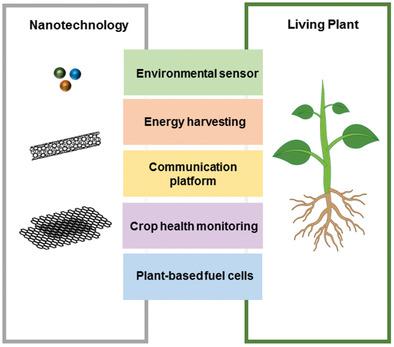当前位置:
X-MOL 学术
›
Adv. Mater. Technol.
›
论文详情
Our official English website, www.x-mol.net, welcomes your
feedback! (Note: you will need to create a separate account there.)
The Emergence of Plant Nanobionics and Living Plants as Technology
Advanced Materials Technologies ( IF 6.4 ) Pub Date : 2019-11-08 , DOI: 10.1002/admt.201900657 Tedrick Thomas Salim Lew 1 , Volodymyr B. Koman 1 , Pavlo Gordiichuk 1 , Minkyung Park 1 , Michael S. Strano 1
Advanced Materials Technologies ( IF 6.4 ) Pub Date : 2019-11-08 , DOI: 10.1002/admt.201900657 Tedrick Thomas Salim Lew 1 , Volodymyr B. Koman 1 , Pavlo Gordiichuk 1 , Minkyung Park 1 , Michael S. Strano 1
Affiliation

|
Plants are naturally abundant and display high sensitivity to ecological factors to thrive in diverse environmental conditions. As sessile organisms, they have evolved complex, internal, and interplant signaling pathways with distinct structures to promptly adjust to the constantly changing environment. In the past five years, the unique ways in which they exchange information with and function in the environment have inspired an emerging field of plant nanobionics, which describes the interface between living plants and nanotechnology to impart the former with novel and useful functions. The structural merits of plant organs and organelles have also inspired the creation of plant‐derived structures through biointerfacing with nanoparticles containing electronic and optical properties. Here, the emerging applications and vision of plant nanobionics are highlighted together with related plant‐inspired materials in potentially replacing the myriad devices in the everyday lives stamped out of plastic, containing circuit boards and consuming power from the electrical grid. Applications in environmental sensing, communication devices, and energy harvesting and conversion are comprehensively discussed.
中文翻译:

植物纳米仿生学和有生命的植物技术的出现
植物自然丰富,对生态因素表现出高度的敏感性,可以在各种环境条件下壮成长。作为无柄生物,它们已经进化出具有独特结构的复杂,内部和植物间信号传导途径,可以迅速适应不断变化的环境。在过去的五年中,它们与环境交换信息并在环境中发挥作用的独特方式激发了植物纳米仿生学的新兴领域,该领域描述了有生命的植物与纳米技术之间的界面,从而赋予前者以新颖而有用的功能。植物器官和细胞器的结构优点还通过与包含电子和光学特性的纳米粒子进行生物接口,激发了植物衍生结构的创建。这里,重点介绍了植物纳米仿生学的新兴应用和前景以及相关的植物启发性材料,这些材料有可能替代日常生活中由塑料制成的无数设备,这些设备由塑料制成,包含电路板并消耗电网的电能。全面讨论了在环境传感,通信设备以及能量收集和转换中的应用。
更新日期:2020-03-09
中文翻译:

植物纳米仿生学和有生命的植物技术的出现
植物自然丰富,对生态因素表现出高度的敏感性,可以在各种环境条件下壮成长。作为无柄生物,它们已经进化出具有独特结构的复杂,内部和植物间信号传导途径,可以迅速适应不断变化的环境。在过去的五年中,它们与环境交换信息并在环境中发挥作用的独特方式激发了植物纳米仿生学的新兴领域,该领域描述了有生命的植物与纳米技术之间的界面,从而赋予前者以新颖而有用的功能。植物器官和细胞器的结构优点还通过与包含电子和光学特性的纳米粒子进行生物接口,激发了植物衍生结构的创建。这里,重点介绍了植物纳米仿生学的新兴应用和前景以及相关的植物启发性材料,这些材料有可能替代日常生活中由塑料制成的无数设备,这些设备由塑料制成,包含电路板并消耗电网的电能。全面讨论了在环境传感,通信设备以及能量收集和转换中的应用。




















































 京公网安备 11010802027423号
京公网安备 11010802027423号